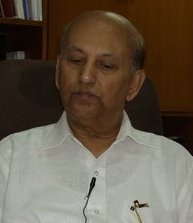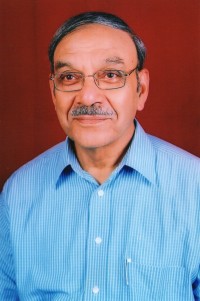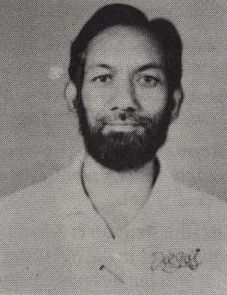Related Research Articles

Vikram Ambalal Sarabhai was an Indian physicist and astronomer who initiated space research and helped to develop nuclear power in India. Often regarded as the "Father of Indian space program", Sarabhai was honored with Padma Bhushan in 1966 and the Padma Vibhushan (posthumously) in 1972.

Venkataraman Radhakrishnan was an Indian space scientist and Royal Swedish Academy of Sciences member. He retired from his career as professor emeritus of the Raman Research Institute in Bangalore, India, of which he had previously been director from 1972 to 1994 and which is named after his father. He served on various committees in various capacities including as the vice president of the International Astronomical Union during 1988–1994. He was also a Foreign Fellow of the Royal Swedish Academy of Sciences and the U.S. National Academy of Sciences. He was an Associate of the Royal Astronomical Society and a Fellow of the Indian Academy of Sciences, Bangalore.

Udupi Ramachandra Rao was an Indian space scientist and former chairman of the Indian Space Research Organisation. He was also the Chairman of the Governing Council of the Physical Research Laboratory at Ahmedabad and Nehru Planetarium at Bengaluru and chancellor of the Indian Institute for Space Science and Technology (IIST) at Thiruvananthapuram. He is known as "The Satellite Man of India". He pioneered India's first satellite launch Aryabhata in 1975.

The Indian Institute of Astrophysics (IIA), with its headquarters in Bengaluru, is an autonomous research institute wholly funded by the Department of Science and Technology, Government of India. IIA conducts research primarily in the areas of astronomy, astrophysics and related fields.

The Physical Research Laboratory is a National Research Institute for space and allied sciences, supported mainly by Department of Space, Government of India. This research laboratory has ongoing research programmes in astronomy and astrophysics, atmospheric sciences and aeronomy, planetary and geosciences, Earth sciences, Solar System studies and theoretical physics. It also manages the Udaipur Solar Observatory and Mount Abu InfraRed Observatory. The PRL is located in Ahmedabad.

The Institute for Plasma Research (IPR) is a public research institute in India. The institute conducts research in plasma science, including basic plasma physics, magnetically confined hot plasmas, and plasma technologies for industrial applications. It is the leading plasma physics organization of India and houses the largest tokamak of India - SST1. IPR plays a major scientific and technical role in Indian partnership in the international fusion energy initiative ITER. It is part of the IndiGO consortium for research on gravitational waves. It is an autonomous body funded by the Department of Atomic Energy.
Dame Carole Jordan,, is a British physicist, astrophysicist, astronomer and academic. Currently, she is Professor Emeritus of Astrophysics at the University of Oxford and Emeritus Fellow at Somerville College, Oxford. From 1994 to 1996, she was President of the Royal Astronomical Society; she was the first woman to hold this appointment. She won the Gold Medal of the Royal Astronomical Society in 2005; she was only the third female recipient following Caroline Herschel in 1828 and Vera Rubin in 1996. She was head of the Rudolf Peierls Centre for Theoretical Physics at the University of Oxford from 2003 to 2004 and 2005 to 2008, and was one of the first female professors in Astronomy in Britain. She was made a Dame Commander of the Order of the British Empire in 2006 for services to physics and astronomy.
Satya Prakash is an Indian plasma physicist and a former senior professor at the Physical Research Laboratory. He is known for his studies on Langmuir probes and other contributions in space and plasma sciences. A protégé of Vikram Sarabhai, Satya Prakash is an elected fellow of all the three major Indian science academies such as Indian Academy of Sciences, Indian National Science Academy and National Academy of Sciences, India as well as the Gujarat Science Academy and is a recipient of the Hari Om Ashram Prerit Senior Scientist Award. The Government of India honored him with Padma Shri, the fourth highest Indian civilian award for his contributions to the discipline of Physics, in 1982.

Shaikh Mohammad Razaullah Ansari was an Indian historian of science, physicist, astronomer and writer.
Bimla Buti was an Indian physicist who specialized in the field of plasma physics. She was the first Indian woman Physicist Fellow of Indian National Science Academy(INSA). In 1994, she was awarded INSA-Vainu Bappu Award.
Annapurni Subramaniam is the director of the Indian Institute of Astrophysics, Bangalore and works on areas like star clusters, stellar evolution and population in galaxies and Magellanic clouds.
Shashikumar Madhusudan Chitre FNA, FASc, FNASc, FRAS was an Indian mathematician and astrophysicist, known for his research in Astronomy and Astrophysics. The Government of India honored him, in 2012, with Padma Bhushan, the third highest civilian award, for his services to the sciences.
Ramanath Cowsik is an Indian astrophysicist and the James S. McDonnell Professor of Space Sciences at Washington University in St. Louis. He is considered by many as the father of astroparticle physics. A recipient of the Shanti Swarup Bhatnagar Prize, Cowsik was honored by the Government of India, in 2002, with the fourth highest Indian civilian award of Padma Shri
Kavasji Naegamvala, also known as Kavasji Dadabhai Naegamvala (1857-1938) (FRAS) was an astrophysicist and the director of the Takhtasingji Observatory.

Mercedes Tharam Richards, née Davis, was a Jamaican astronomy and astrophysics professor. Her investigation focused on computational astrophysics, stellar astrophysics and exoplanets and brown dwarfs, and the physical dynamics of interacting binary stars systems. However, her pioneering research in the tomography of interacting binary star systems and cataclysmic variable stars to predict magnetic activity and simulate gas flow is her most known work.
RESPOND is a sponsored research program of Indian Space Research Organization. ISRO started the RESPOND programme in the 1970s whose main objective is to establish strong links with Universities/Institutions in the country to carry out quality research and developmental projects which are of relevance to space and derive useful outputs of such R&D to support ISRO programmes. The programme provides opportunity to the non-ISRO scientists and engineers, who are working with the recognized institute, to contribute to the Indian space programme. The contribution is mostly in areas of design and development of orbiting satellites for scientific research and space applications, sounding rockets and satellite launch vehicles. Non-academic R & D institutions can also participate in this programme.

Vijay Kumar Kapahi was an Indian astrophysicist and the director of the National Centre for Radio Astrophysics, an autonomous division of Tata Institute of Fundamental Research. Known for his research on radio galaxies, quasars and observational cosmology, Kapahi was an elected fellow of all the three major Indian science academies – Indian Academy of Sciences, Indian National Science Academy and National Academy of Sciences, India – as well as of the Maharashtra Academy of Sciences. The Council of Scientific and Industrial Research, the apex agency of the Government of India for scientific research, awarded him the Shanti Swarup Bhatnagar Prize for Science and Technology for his contributions to physical sciences in 1987.
Nissim Kanekar is an Indian astrophysicist, cosmologist and a professor at National Centre for Radio Astrophysics of Tata Institute of Fundamental Research. Known for his research on the evolution of the electron proton mass ratio, Kanekar is a member of the International Astronomical Union and a recipient of Swarna Jayathi Fellowship of the Department of Science and Technology. The Council of Scientific and Industrial Research, the apex agency of the Government of India for scientific research, awarded him the Shanti Swarup Bhatnagar Prize for Science and Technology, one of the highest Indian science awards, for his contributions to physical sciences in 2017.

Ajit Kembhavi is an Indian astrophysicist. He is presently a professor emeritus at the Inter-University Centre for Astronomy and Astrophysics, (IUCAA) at Pune, India, of which he was also a founder member. He also serves as a vice president of the International Astronomical Union. He is the Principal Investigator of Pune Knowledge Cluster along with Professor L. S. Shashidhara.
Aina Margareta Elvius was a Swedish astronomer known for her work on polarized light from galaxies and the nuclei of active galaxies. She was professor of astronomy at Stockholm University, director of the Stockholm Observatory, and the second Swedish woman to be elected to the Royal Swedish Academy of Sciences.
References
- 1 2 3 4 5 6 7 Women Scientists in India . National Book Trust, India. p. 209.
- 1 2 3 4 5 6 7 8 Rohini Godbole (editor), Ram Ramaswamy (editor) (31 October 2008). Lilavati's Daughters: The Women Scientists of India. pp. 163–165, 359.
{{cite book}}:|last=has generic name (help) - 1 2 "Hari Om Ashram Prerit Vikram Sarabhai Research Award Awardees List". Physical Research Laboratory of the Department of Space. Retrieved 14 March 2021.
- 1 2 "Vinod Krishan". Indian Institute of Astrophysics. Retrieved 16 March 2014.
- ↑ "Professor Vinod Krishan-Research Profile". Indian Institute of Astrophysics. Retrieved 16 March 2014.
- ↑ "Professor Vinod Krishan-Memberships & Awards". Indian Institute of Astrophysics. Retrieved 16 March 2014.
- ↑ "International Astronomical Union | IAU". www.iau.org. Retrieved 14 March 2021.
- 1 2 Basic Plasma Processes on the Sun: Proceedings of the 142nd Symposium of the International Astronomical Union Held in Bangalore, India, December 1–5, 1989. Netherlands, Springer Netherlands, 1990.
- ↑ "Professor Vinod Krishan-List of Publications". Indian Institute of Astrophysics. Retrieved 16 March 2014.
- ↑ "Professor Vinod Krishan-Editorial Work". Indian Institute of Astrophysics. Retrieved 16 March 2015.
- ↑ "inauthor:"Vinod Krishan" - Google Books Search". www.google.com. Retrieved 14 March 2021.